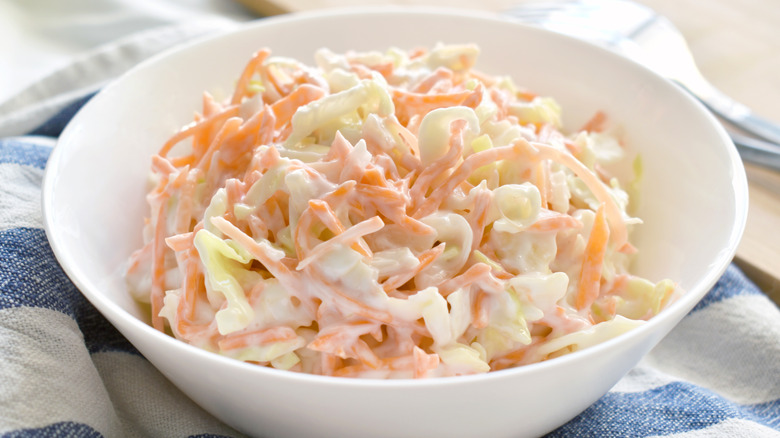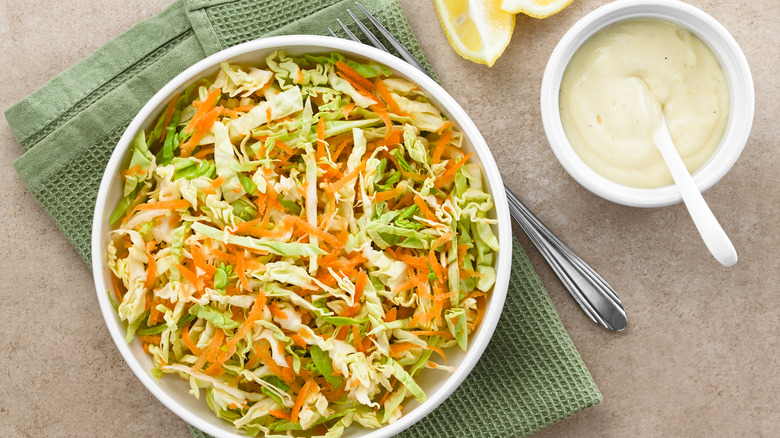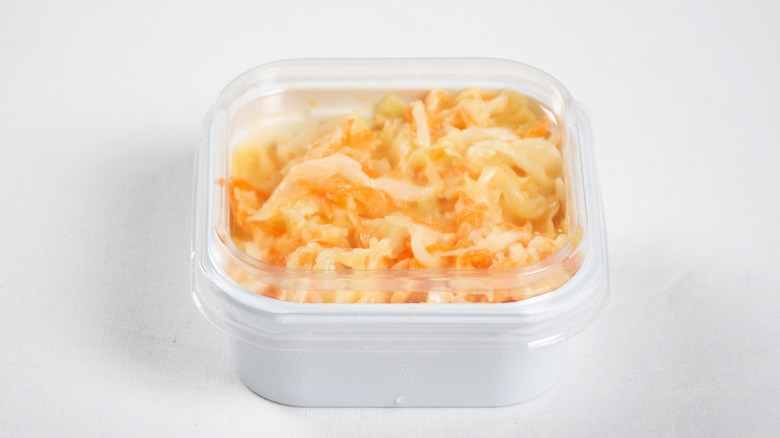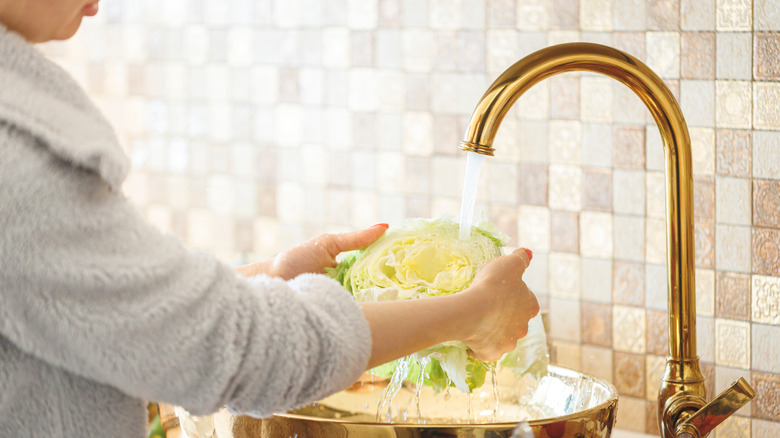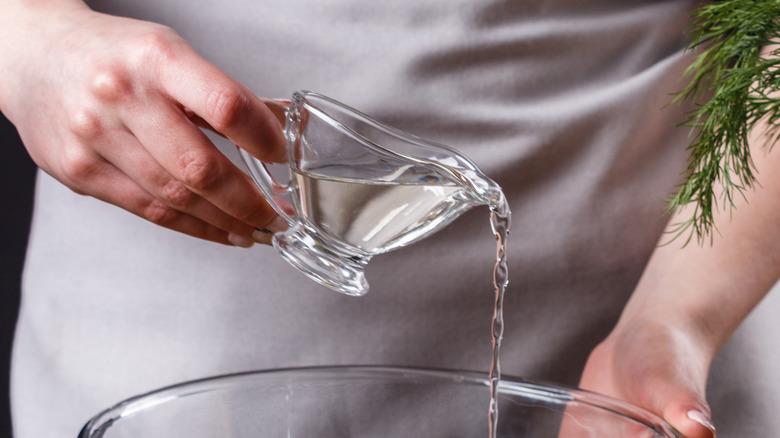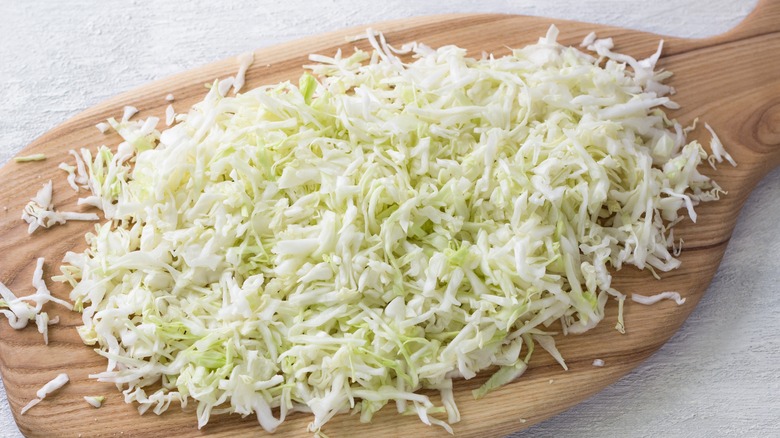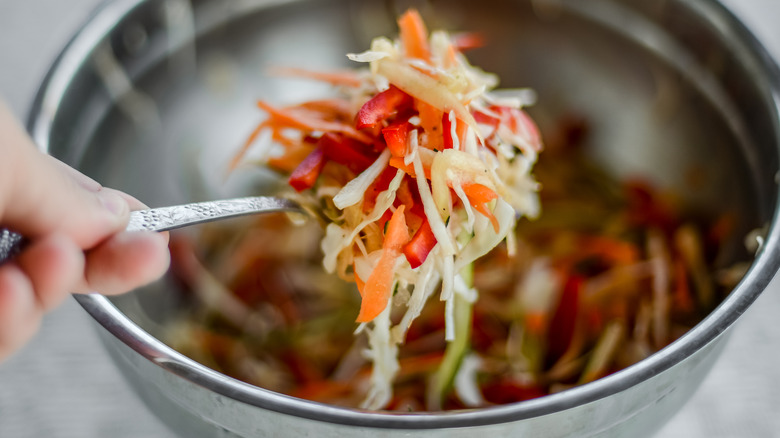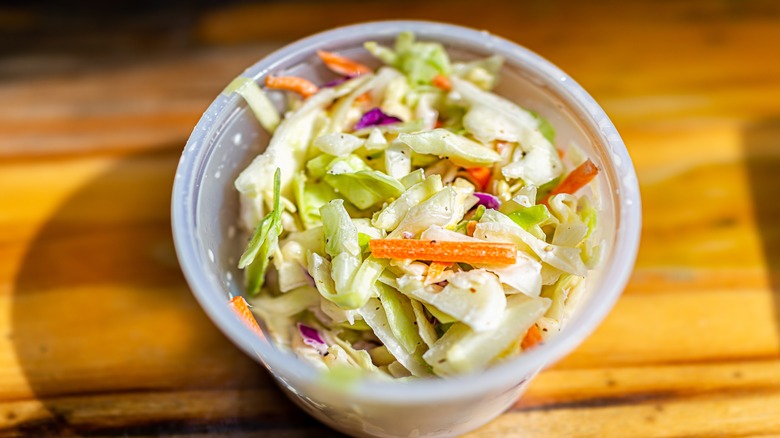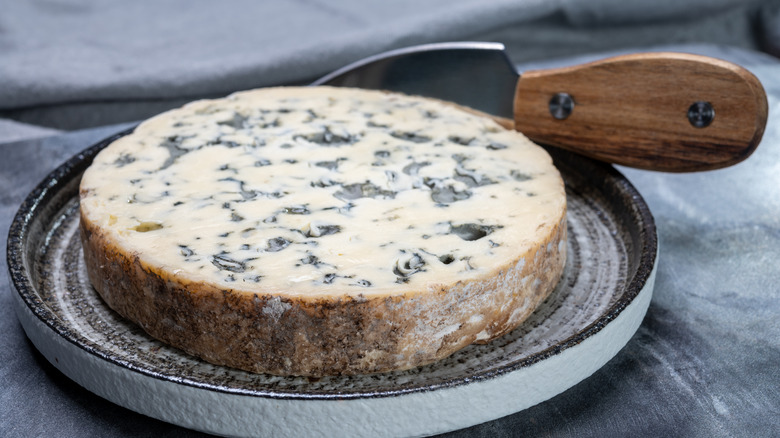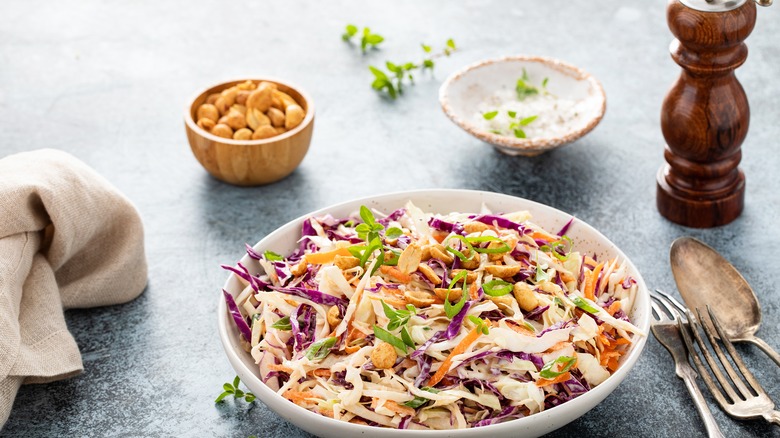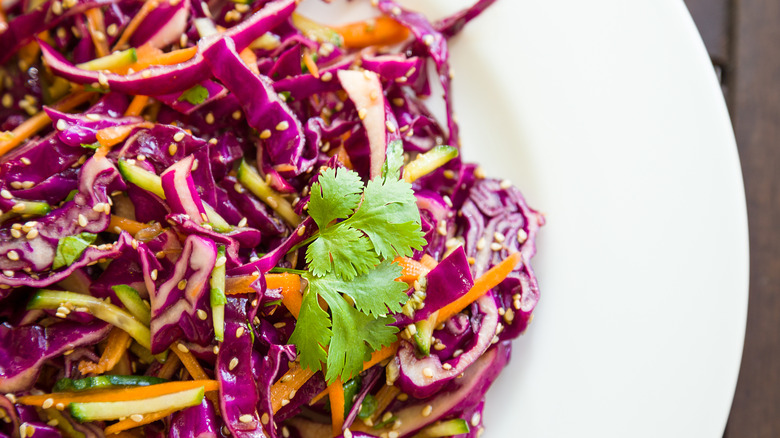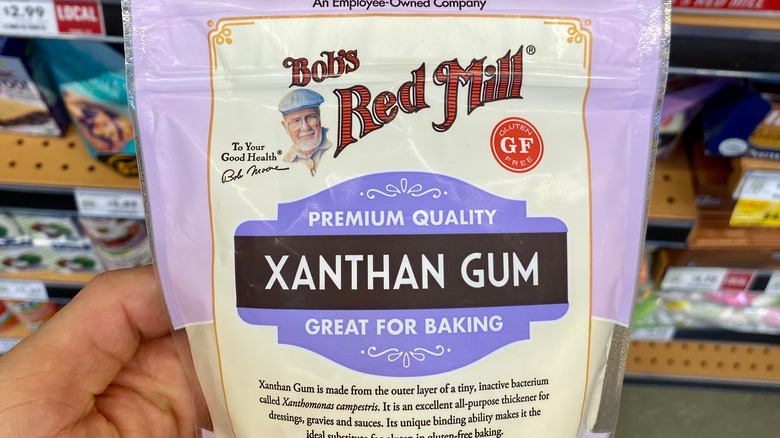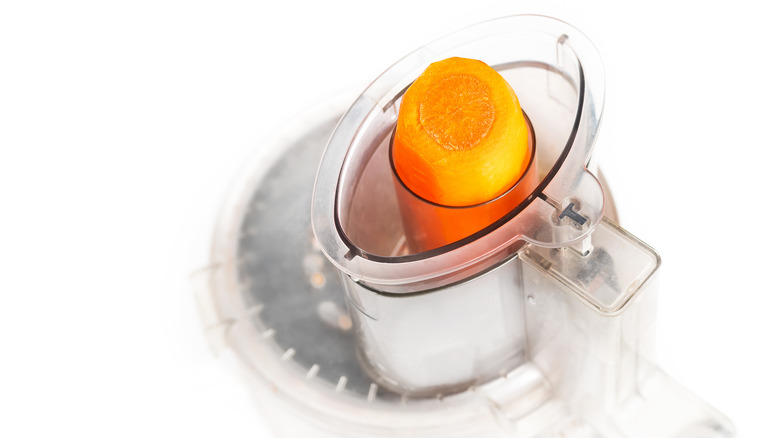The 14 Biggest Mistakes Everyone Makes When Making Coleslaw
Coleslaw — love it or hate it, it's not going anywhere anytime soon. According to NPR, coleslaw was originally made by the Romans before it was eventually brought to the Americas with the migration of the Dutch. The word coleslaw originates from the Dutch word "kool sla" — "kool" meaning cabbage and "sla" meaning salad. And although we serve coleslaw cold, likely the first recipes were not served cold. The first coleslaw recipes likely included cabbage, vinegar, eggs, and spices, which isn't far from the modern preparation technique of salted and shredded vegetables tossed in a dressing.
The one prerequisite for coleslaw being a true coleslaw is cabbage. Recipe adaptations have included other ingredients like shredded carrots, zucchini, and fruit, as well as creative herbs and sauces that will make you rethink your regular tailgate 'slaw. Here are some of the most common mistakes folks make when preparing this classic side, as well as simple tips for preparing an innovative and delicious coleslaw.
Not salting your cabbage
Salting your cabbage is a critical first step to making coleslaw. Once the cabbage is cut, it starts leaking water. Too much water will not only dilute the seasoning in your dressing, but it will also make your dressing watery, sad, and ultimately unappetizing. Adding salt to your cabbage, according to The New York Times, will draw the water out of the cabbage faster by way of osmosis and allows you to dry it before adding seasoning and dressing. Salting the cabbage also makes it more tender, but not so tender that the vegetable loses its satisfying crunch.
There are two ways in which you can salt your cabbage. The first way is to add granulated salt to the cabbage once it is washed and in a colander. You'll need to wait between one and four hours for the water to drip from the cabbage before you can pat it dry with a kitchen towel and go about making the rest of your coleslaw. The other method is to soak the cabbage (as well as the radishes and carrots, if you plan to use them) in a salty brine for at least six hours. Then, drain off the excess water and dry your vegetables.
Adding your dressing prematurely
As exciting as it can be to add your coleslaw dressing to your freshly tossed bowl of veggies, you should refrain for as long as possible. Add your dressing no more than 20 minutes from when you plan to serve your coleslaw. You should also gradually add your coleslaw, tossing it in between dressing, to prevent swamping it and causing the cabbage to lose its crunch. This is because when you add dressing to your coleslaw, the chemical reaction causes the pectin in the cell walls of the cabbage to release more moisture.
If you're on a time crunch, you can prepare your coleslaw dressing and store it in an air-tight container for up to three days before dressing the vegetables. Our favorite homemade coleslaw dressing recipe is made with mayonnaise, honey for sweetness, rice wine vinegar for tang, and salt and pepper. Besides using dressing for coleslaw, you can also use it as a spread on a sandwich or for a crudités dip.
Leaving your coleslaw in the refrigerator for too long
Leaving coleslaw in the fridge for too long carries detrimental consequences. Does It Go Bad recommends sticking to a three to four-day window to eat your homemade coleslaw after it's prepared. Over time, the coleslaw will become more watery and soup-like, and you'll notice that the dressing loses its flavor over time. But, unless there are obvious signs of spoilage, such as mold, discoloration, a foul smell, or poor taste, your wilted coleslaw is likely still good to eat. If you want to skip the homemade coleslaw and purchase the side from a local deli, Does It Go Bad recommends abiding by a one to two-day grace period after the "best by" date printed on the package.
If you want to prolong the storage time of your coleslaw, you should store it in an air-tight container in the fridge. This will prevent the infiltration of strange smells from the other foods in your refrigerator. You can also use aluminum foil or plastic wrap to seal your coleslaw, but be sure to press all the edges closed to prevent your coleslaw from drying out.
Not washing your vegetables first
Cabbage, like lettuce, grows in heads close to the ground. This proximity, along with the conditions in which it is grown, puts cabbage at a greater risk for food-borne illnesses like E. coli and instances of bugs burrowed inside of your cabbage (gross).
To clean your cabbage at home, you should remove the outer leaves and any layers covered in dirt (and it can't hurt to remove all the layers for good measure). Once you remove the exterior of the lettuce, you can slice it into wedges with a sharp chef's knife and dunk the wedges in cool water to remove any bugs or dirt left in the inner layers of the cabbage. To kill off leftover bacteria, make a bath with ½ cup of vinegar per each cup of water, (via the Colorado State University Department of Extension). Then, rinse the pieces under cool water to remove any excess dirt or critters hiding in the leaves.
Overloading your coleslaw with vinegar
Vinegar is both a blessing and a curse when it comes to coleslaw. If the amount of vinegar in your coleslaw makes your eyes water and your mouth pucker, you probably added a bit too much. Luckily, there are some things you can do to balance out the tartness of vinegar in your recipe. You can add other seasonings to counteract the tartness of the dish. Depending on your coleslaw recipe, this may include adding a couple of tablespoons of mayonnaise, a splash of oil, or sweeteners like maple syrup and agave.
If you are against adding other seasonings as a last-ditch effort to save your coleslaw, you can take some other remedial steps. Strain out the excess vinegar with a colander and a handy kitchen towel, or dilute the vinegar by adding an extra serving of unseasoned veggies to your coleslaw. In hindsight, you should stick to the recipe, as well as taste your coleslaw as you go along to make sure it has just the right amount of tang.
Using too much salt
As previously noted, salt is a vital ingredient in coleslaw because it both softens and seasons the cabbage and vegetables. But, there are also common complications for adding too much salt to your coleslaw — most notably, a taste similar to that of salt and vinegar potato chips. When you're working with coleslaw, you should note all the seasonings that can contribute to a salty coleslaw, including granulated salt, salt brine, or ingredients like soy sauce.
If you add too much salt to your coleslaw and neglect to taste-test it along the way, SF Gate notes there are some, albeit unconventional, ways to soak up the extra salt. You can rinse the cabbage under cold water to drain the excess salt, which essentially puts you back at step one for making coleslaw. The website also recommends adding a scant amount of brown sugar or cream to balance out the flavors in the slaw. But, this can lead to more issues with flavor and texture if you add too much of either of these ingredients. Vinegar can also be used to balance some of the saltiness of the slaw.
Adding too much sugar
Sugar might not be a popular ingredient for coleslaw, but it can be used to help balance some of the tartness and the saltiness of the other flavors in the dish. When adding sugar or an alternative sweetener like maple syrup to your coleslaw, you should always work gradually. We doubt your guests want their savory side dish to taste like it is straight out of a pastry shop rather than a deli.
If you accidentally add too much sugar to your coleslaw, you can balance out the sweetness with other ingredients. You can add red wine or distilled white vinegar to combat the sweetness. You can also add other ingredients like yogurt, lemon juice, or olive oil to diminish the sweetness of the coleslaw. The best method of moderating sweetness in coleslaw, though, is undoubtedly prevention. Taste your coleslaw as you're making it and stick to adding your sugar slowly and gradually.
Not freezing your coleslaw for a later date
Freezing coleslaw — really? This tip works best for vinegar-based coleslaw recipes rather than mayonnaise-based coleslaw. This is because mayonnaise is made from an emulsion of eggs and oil. When the mayonnaise freezes, it tends to separate and creates a peculiar, and unappetizing, texture. Coleslaw made with Miracle Whip tends to freeze better than regular mayonnaise dressing because it is made with less oil, more eggs, and cornstarch — which separate less.
We recommend freezing coleslaw for a maximum of six months before eating it. If you're using a mayonnaise-based coleslaw, you should stick to freezing the cabbage and veggies separately and then dressing your coleslaw after it's thawed. If you're working with just the vegetables, you can the shreds to prevent browning, as well as use an acid like lemon juice or vinegar to prevent color loss over time, if that's something that concerns you.
Not microwaving your cabbage
Don't worry, we're still serving coleslaw cold. But microwaving your cabbage can actually help soften the shreds and expedite the water-loss process. Instead of salting and waiting hours for your cabbage to release its water, you can add the cabbage shreds with salt and sugar into a microwave-safe bowl. Then, microwave the bowl for about three minutes and let the shreds stand for about five minutes. After that, you can rub off the excess moisture from the cabbage with a kitchen towel and ring out any excess moisture.
After your cabbage has sweat off its moisture, you can toss it with your favorite dressing or seasoning. As with all coleslaws (microwaved or not), you should allocate a small window of time for your cabbage to chill in the refrigerator and meld with the flavor of your dressing. This time will allow any softening ingredients, like vinegar or salt in the dressing, to loosen up the cabbage.
Not trying to add blue cheese
Food personality Ina Garten makes her barbecue-ready coleslaw with a few standard ingredients like red and green cabbage, Dijon mustard, vinegar, mayonnaise, and tons of fresh herbs. But the one ingredient you wouldn't expect to see in a coleslaw? Blue cheese.
Blue cheese is an aromatic variety of aged cheese that can contrast with the sweetness of brown sugar and tartness from the vinegar in your coleslaw. Garten uses fresh Roquefort blue cheese for its punchiness; the freshness of the cheese is imperative for both its flavor and its active mold cultures. This coleslaw recipe is perfect for a burger topping because of the crunch from the coleslaw and the aromatic, pungent flavor of the blue cheese. You can also get creative and add bacon bits and freshly grated onion to your slaw to amplify the textures and flavors of the blue cheese. And while Garten recommends using good-quality mayonnaise for this dish, we also see some potential in using other dairy ingredients like sour cream or yogurt.
Sticking to the same recipe
There are a lot of merits in keeping a good, classic, and fool-proof coleslaw recipe around. But, coleslaw doesn't always have to include the same boring combination of mayonnaise and vinegar. Once you understand the basic formula for making coleslaw (shredded vegetables, salt, dressing, and seasoning), you can craft a recipe for coleslaw that's all your own.
One of our favorite ways to "class up" coleslaw is to make a Californian version with Napa cabbage, sliced fennel bulbs, chopped fennel fronds, celery, grapefruit, avocado, and chopped almonds. The grapefruit, which is both added as acid and chopped segments, provides a unique pop of flavor and color. The avocado is an essential contrast to the crunchiness of the cabbage. You can also char the fruits and vegetables in your coleslaw on the grill before mixing in with your dressing and seasoning. Our favorites to grill include leeks, nectarines, and cabbage wedges.
Omitting a spicy flavor
Heat is an underrated element in cooking — and coleslaw. One way to add subtle heat to your coleslaw is to add chopped pepperoncini with your vegetables. These peppers are not as spicy as jalapeños, and you'll get a bit of crunch in your coleslaw, too. Another potential ingredient you can add to your coleslaw is grated fresh ginger. Not only does this root have a heavenly aroma, but you'll get a bit of a kick if you grate it into your coleslaw dressing.
If you tend to make Asian-inspired slaws, you have numerous ingredients available to you to add a special kick to your coleslaw. Gojuchang, a Korean hot sauce, is used as a marinade, ingredient, and condiment in many Asian recipes. The paste is thick and can be diluted with vinegar, soy sauce, or oil to round out its flavor. You can also use Kewpie mayo instead of regular mayonnaise to make your coleslaw. Kewpie mayo has a more pronounced egginess and MSG flavor that complements the heat of gojuchang, chili oil, or red pepper flakes.
Not using xanthan gum to thicken
Xanthan gum is a niche ingredient known to many gluten-free bakers for its thickening qualities. This is why we recommend using the powder as a thickening agent in a coleslaw recipe.
Xanthan gum is a fermented additive from the Xanthomonas campestris bacteria. When the powder comes into contact with a liquid, it creates a gel-like consistency that can act as a binder in baked goods or a thickener in gravy. The amount of xanthan gum you'll use in any recipe, coleslaw or not, is small. You can use a ¼ teaspoon of xanthan gum in your copycat KFC coleslaw to thicken up the dressing, which is made with canola oil, mayonnaise, sugar, apple cider vinegar, and xanthan gum. You'll find this dressing super thick and perfect for binding together the tiny flecks of grated cabbage and carrot in the coleslaw. And if you don't want to run out to the store to pick up a bag of xanthan gum, you can skip using it in a recipe — although you may have to drain your coleslaw again before serving.
Neglecting the food processor for easy chopping
The go-to kitchen appliance for many folks when making coleslaw is a box grater. While this method may get you the uniform pieces you want in your coleslaw, you may find yourself tossing the end of your veggies away if you don't want to get part of your hand scraped off in the process. If you want minuscule pieces of cabbage and carrot, you'll want to pulse down your cabbage wedges and vegetables into tiny pieces. Depending on the size of your food processor, you may need to cut your vegetables down with a knife or a mandolin to get everything to fit into the vessel. For this type of coleslaw, you'll want to pulse the veggies until the texture resembles rice.
You can still use a food processor to grate your coleslaw veggies — even if you don't want a rice-like texture. You can add a grating blade attachment to your food processor and slowly add your veggies to the machine. You won't have to worry about grating down your fingers or cleaning a box grater for coleslaw ever again.
